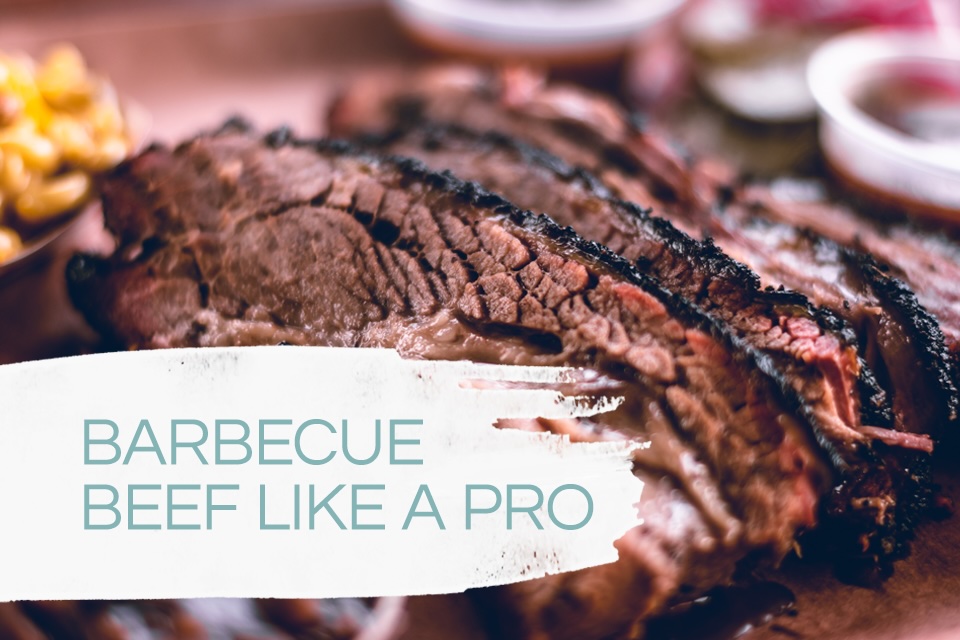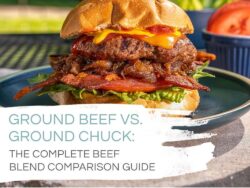
The Beginner’s Guide to the Perfect Beef BBQ
Aug 12, 2020 | Cooking with Beef
The taste of good barbecue is unmistakable. Smoky, pull-apart tender, sweet—or tangy, or spicy. Whichever way you like your beef barbecue, it can be intimidating to try to master it yourself. Whether you’ve already tried your hand at it and want to up your skills or you’re just getting started, we’ve put together a few tips to have you grilling mouthwatering beef barbecue in no time.
But first, some terms to know …
BBQ Slang
Barbecuing has a rich history spanning back to colonial times (and maybe even before). Over time, the cooking method has become such a significant part of American culture that there are TV shows about it, a region of the country aptly named “the barbecue belt” (the Carolinas to Texas), and plenty of debates about the right way to do it.
You may have heard of BBQ pitmasters from the TV show with the same name, but if you haven’t, it means exactly what it sounds like: masters of barbecuing. This term is commonly used among aspiring barbecuers in all regions of the country. If you’re reading this blog, you may have the goal to become one.
Some other commonly used terms:
- Brine: A mixture of seasonings and liquid that beef marinades in prior to cooking.
- Burnt Ends: The points of the brisket that produce a crunchy, chewy texture.
- Bark: The chewy outsides of beef brisket that has been smoked.
- Dalmatian Rub: Seasoning with only salt and pepper.
- Low and Slow: A cooking technique (that pitmasters swear by) in which meat is cooked at a low temperature for several hours.
- Pit: Can refer to any barbecuing equipment (a grill, smoker, or traditionally, a hole in the ground over which meat was cooked).
- Pit Boss: Someone who oversees the barbecue . Interchangeable with “pitmaster.”
- Skinning the Brisket: The process of trimming the fat on a brisket. Can be done both before and after smoking.
- Smoking: A method of cooking and flavoring meat by exposing it to smoke (usually from wood chips).
The Beef Cuts

Traditionally, beef ribs and brisket are the most common cuts used for barbecuing. When it comes to ribs, you can choose back ribs—the signature ribs for smoking and barbecue —or chuck short ribs, which are meaty and tender and can be served boneless. Brisket is a classic cut for smoking and “low and slow” cooking to add tenderness and rich flavor. It is often served sliced and on sandwiches. You can use a whole beef brisket for additional marbling and tenderness, or the flat half for a leaner option. If you want to cook pulled beef for BBQ sandwiches, you can slow cook a chuck roast or sirloin tip roast.

Aspen Ridge Natural Angus Short Ribs
What You’ll Need
Cooking equipment and utensils can vary depending on which cut and the barbecuing technique you use.
The most common equipment for barbecuing beef includes:
- A grill (pitmasters recommend charcoal rather than gas), best for: ribs and brisket.
- A slow cooker, best for: pulled beef.
- Bonus points for a meat smoker or grates for cooking over an open pit (works well for any cut).

Brisket over a charcoal grill
Utensils and accessories
- Gloves
- Tongs
- BBQ cutlery, steak knives, or brisket slicing knives
- A meat thermometer
- A basting brush
- Aluminum foil
- A butcher’s block
- Bonus points for rib racks, an apron, and bear paw claws

Bear paw shredder claws. Image courtesy of BBQ Butler.
Beef BBQ Rubs
Aspen Ridge® Natural Angus Beef is exceptionally flavorful, so a “Dalmatian rub” of salt and pepper seasoning is all you need. If you want to branch out and try other rubs, common seasonings include paprika, garlic powder, onion powder, and mustard powder.
Beef BBQ Sauces
When it comes to barbecue sauces, there are endless opportunities for flavors! There are a few camps on the best styles: tangy, sweet, sour, mustard-based, and even mayonnaise. The kind of sauce you use largely comes down to your individual flavor preferences, but for beef, we recommend Texas-style BBQ sauce, which is thick with a molasses consistency to keep the beef moist. If you want to make your own sauce and become a BBQ connoisseur, Taste of Home shares 12 regional styles to try.

Beef brisket with Texas-style BBQ sauce
Woodchips for Barbecuing Beef
The best woodchips for barbecuing beef come from hardwood and include mesquite, oak, and hickory, which have bolder flavors than other woods and can penetrate the thicker cuts of beef. These woods have strong, smoky flavors, so you’ll want to use them sparingly if you’re unsure about how much smokiness you like.
Barbecuing Techniques and Cooking Times
As mentioned above, barbecuing techniques can vary based on beef cut and flavor preference. The three major techniques are smoking, grilling, and slow cooking. If you’re barbecuing for the first time, we recommend a charcoal grill and indirect grilling to cook beef slowly over the course of an hour or so. Avoid checking the meat too often to prevent losing heat. Wrap wood chips in foil and set on the grill plates to add a hint of smoke.
If you’re a pitmaster in the making, you can try your hand at using a smoker or cooking beef over an open flame. Get the basics for using a smoker to cook beef from Beef. It’s What’s for Dinner® and use the “low and slow” cooking technique (smoke for up to 12 hours) to bring out the full flavor and tenderness of the beef.
The Beef Makes the Barbecue
Mouthwatering barbecue starts with high-quality beef. Naturally-raised Angus beef offers unmatched tenderness and flavor, and Aspen Ridge products grade as Prime or Choice on the USDA beef quality grading scale.
Learn more about what makes Aspen Ridge Natural Angus Beef unparalleled or get tasty beef barbecue recipes from Beef. It’s What’s for Dinner. The right beef and the right cooking techniques make barbecuing like a pro easy.



